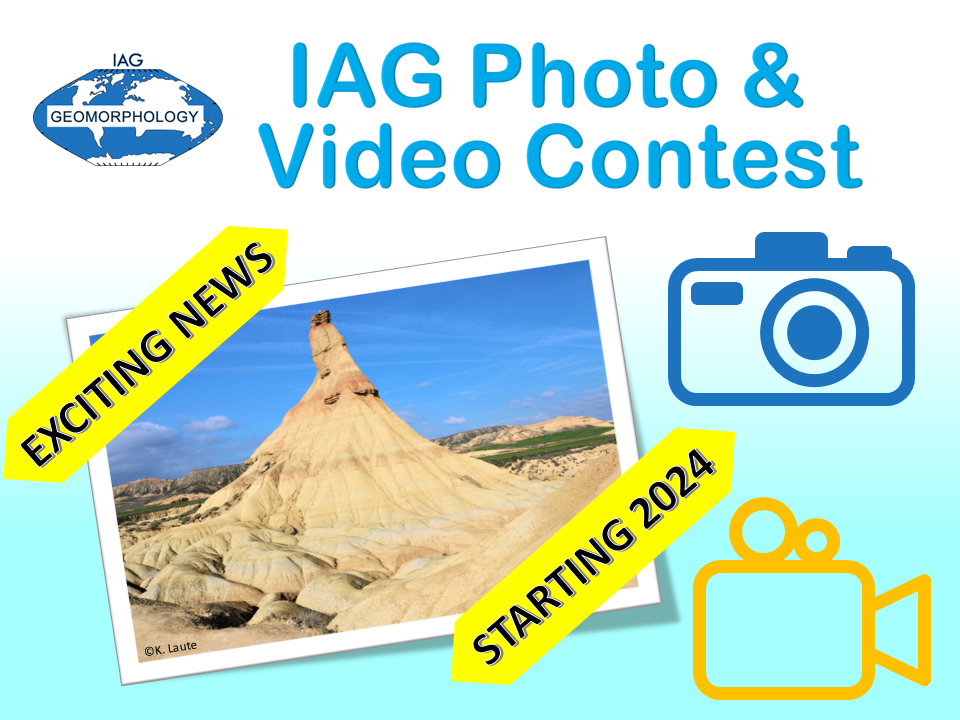IAG Photo & Video Contest

The IAG is happy to announce the launching of its new Photo and Video Contest! Starting this January, it will run from 2024-2026. Find below the details on conditions, prizes and guidelines for the contest – as well as an example for photo submission. Find also the list of current and previous themes at the bottom of the page.
Conditions:
The contest is open to geomorphologists worldwide, belonging to active National Scientific Members of the IAG.
Every month will have its own theme, announced well in advance. Participants will be able to send us their best photo related to that theme – as well as a text describing the scope of the photo/video and its scientific interest (location, landform, process). A Selection Committee* will evaluate all photos submitted by the 20th of each month to select the monthly winner. The evaluation will be based on the scientific importance of the photo/video, their relevance to the theme, the overall aesthetics and composition of the image, and the clarity of the descriptive text. The Winner will see their photo posted on the IAG website and shared on the IAG social media, along with its descriptive text. Guidelines for submission are detailed below.
Every three months, in addition to the photo selection, a specific theme will be announced and a video related to that theme will be selected. The selection conditions will be the same as for the photo contest (detailed guidelines below).
An appropriate example of a photo submission is available below, and here in pdf (the example will not enter the competition).
Prizes:
Every year, the 12 Winners of the photo contests and the 4 Winners of the video contests will be put in competition. The Selection Committee* will choose one photo and one video among those, designating an Overall Winner for both the photo and the video contests. The two Overall Winners will be granted 50% reduced registration fees for a given IAG international or regional conference.
Guidelines:
- Participants must belong to one of the active IAG National Scientific Members;
- Participants must submit their photo/video before the 20th of each month;
- Themes will be announced in advance;
- Photos must be in JPG, PNG or TIFF formats, and must not exceed 5 Mb;
- Videos must be in MP4 or WebM formats, and must not exceed 200 Mb and 2 minutes;
- A brief text (≤ 150 words) summarising the scientific interest of the photo/video must be provided;
- Both the photo/video and the text have to be sent to the IAG via an online storage link (e.g. Dropbox or Google Drive), at iaggeomorph@gmail.com (subject: ‘Photo & Video Contest‘);
- One author can make a single submission once;
- Previous Winners are not allowed to participate again within the same year;
- By submitting your photo/video, you agree that the IAG can use it for illustration purposes on its website, social media, and trimestral Highlights;
- By submitting a photo/video, participants declare bindingly that they are the authors of the photos/videos and that they own all image rights. The rights of third parties may not conflict with publication. Furthermore, participants agree to the free publication of their photos/videos submitted as part of the contest, and to the announcing of their full name and of the title of the photo/video by the contest organiser. All image rights remain with participants. By participating in this contest, participants accept these terms and conditions.
*The Selection Committee is constituted of active IAG members (part of the Executive Committee or not) and Young Geomorphologists (members of IAG Network of Young Geomorphologists’ Groups) – with a balance kept. As the contest is aimed at being perennial, the Selection Committee will be subject to change in the future.
Example for photo submission (pdf here):

Pinnacle – striking example of dryland erosion
by Katja Laute, Selbustrand, Norway
The Castil de Tierra has become the symbol of the Bardenas Reales region which is geographically located in the south-eastern margin of the Navarra Province in northern Spain. The Bardenas Reales is a semi-desert natural region situated in the middle-western sector of the Ebro depression. The geology is made up of Tertiary and Quaternary sediments. Rainfall events, wind and high temperatures enhance surface wash and erosional processes and have created fascinating erosional features and landforms such as canyons, isolated hills and talus flatirons. The Castil de Tierra is a striking example for differential erosion of the predominant clays and sandstones and the related landforms. Pinnacles like this one are usually considered penultimate stages of tableland dissection (via mesas and buttes).
List of themes
Photo contest
| April 2024 | Coastal landscapes and climate change |
| March 2024 | Glacial geomorphology and climate warming |
| February 2024 | Surface karst landforms |
| January 2024 | Volcanic landforms and landscapes |
Video contest
| April-June 2024 | Landslide risk |
| January-March 2024 | Volcanic landforms and landscapes |
